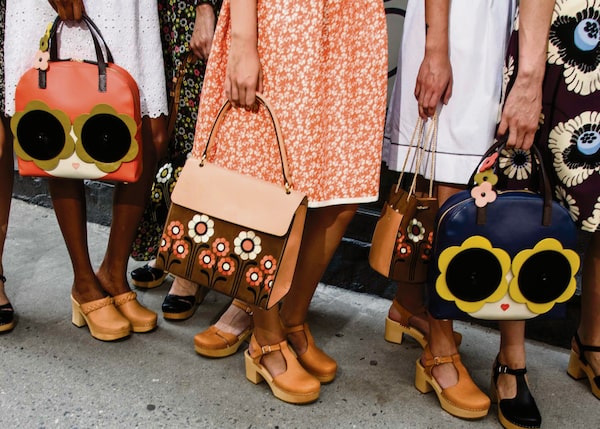If you were to measure a designer’s success by how hard she is to pin down, Orla Kiely would rank somewhere above Giorgio Armani. Ahead of A Life in Pattern, an exhibition of her work at London’s Fashion and Textile Museum opening May 25, she is as elusive as the chunky platform heels she created for Clarks, which have long since sold out.

Orla Kiely’s designs show commitment to varied, distinctive and fresh patterns.
Perhaps her time poverty can be blamed on living a multicoastal existence. Since opening a dedicated boutique in New York’s West Village and five in Korea, Kiely is as popular abroad as in her native Ireland, where the mossy hills, misty skies and mustard wildflowers have influenced her collections since the 1990s. Following a massive 1,500-store collaboration with Japan-based Uniqlo, she is working toward a baker’s dozen of standalone retail spaces in Tokyo. Despite her global reach – and $15-million in annual sales – the 55-year-old still manages to come off as the designer next door – albeit one whose London house displays her own retro yellow wallpaper and branded throw-cushions. She is her own best top model in flowered frocks and pinafores, a fair-haired Kate Spade for the middle class.
When Kiely finally comes up for air, we discuss everything that led to the new exhibition and why it makes sense for her first retrospective to focus on fabric design. Though one of her early mentors was Irish clothing designer Paul Costelloe – “I assisted him on projects like designing the Irish Post Office uniform and learned the process from start to finish,” she says – she did, she stresses, begin as a creator of prints.
Fresh out of art college in Dublin, Kiely mixed colours for a New York textile manufacturer who shared her fondness for muddy, natural tones. She followed this with an MA in knitwear at London’s Royal College of Art. While selling knit hats at London Fashion Week in the nineties, Kiely experienced her lightning-bolt moment. “My father had come to see our tiny stand,” she says, “and his observation was that everyone was carrying a [hand]bag but they weren’t all wearing hats.” His insight prompted her to track down a factory that could produce small runs of backpacks and satchels that she would go on to sell through London boutiques.

Orla Kiely’s handbags are the bestselling items in her business.Hannah Thomson
“As we grew, we sourced new suppliers in Italy and developed the collections,” Kiely tells me. It was during another London Fashion Week showing – more official this time – that she realized the cultural crossover potential of her aesthetic. “A group of Japanese buyers swarmed our stand and placed orders,” she says. “Their excitement was only a hint of what was to come.”
The bags weren’t printed in the beginning, but that changed when she created a symmetrical leaf pattern she called “Stem.” “That came in the middle of developing new print designs back in 2000,” she says. “It was, as all good things seem to be, a very quick sketch that became the land our company is built on.” Stem became to Kiely as the multicoloured stripe is to Paul Smith or the check is to Burberry: a “feel-good moment for people when they see it.”

Kiely’s ubiquitous mugs.
It ended up, Kiely admits, on a whole world of products, from bicycles to camping tents to her ubiquitous mugs. On the verge of oversaturation, fashion saved her. According to Kiely’s husband and business partner, Dermott Rowan, handbags remain the bestsellers of the business, but tea dresses and scallop-printed sweaters in sunset shades now make up about 35 per cent of sales. Kiely’s four seasonal collections have pushed ahead by rebelling against the monochrome-mania of the past decade, and profited from our embrace of year-round florals and colour-blocking, whether paired with biker jackets or music-festival flower crowns. The clothes have also earned her credibility in New York, where she plans to invest heavily over the next few years – and indeed in Canada, where she’s stocked at Room6 in Vancouver.
But what won Kiely this summer show at the FTM is her commitment to pattern: varied, distinctive and fresh, though the patterns could live quite comfortably in the 1960s. More than 150 archival patterns and products feature at the FTM: motifs of pears and flowers inspired by Kiely’s childhood in Dublin in palettes that draw from dull days on Irish beaches. Kiely chalks up the retro quality of her work to her admiration for British textile designer Barbara Brown, whose prints adorned furnishings at the Heal’s store in London in the 1960s and ’70s. And for mid-century furniture designers such as Arne Jacobsen and Carlo Scarpa. “Their vision is one I have always loved,” she says. “I always see something new, every time.”
That element of nostalgia also came to the forefront while she dug through her archives for the exhibition. “Rediscovering bags from over 20 years ago, seeing how far we have come,” says Kiely, “has been unlike anything else.”
Orla Kiely: A Life in Pattern runs from May 25 to Sept. 23 at the Fashion and Textile Museum in London (ftmlondon.org).
Visit tgam.ca/newsletters to sign up for the Globe Style e-newsletter, your weekly digital guide to the players and trends influencing fashion, design and entertaining, plus shopping tips and inspiration for living well. And follow Globe Style on Instagram @globestyle.